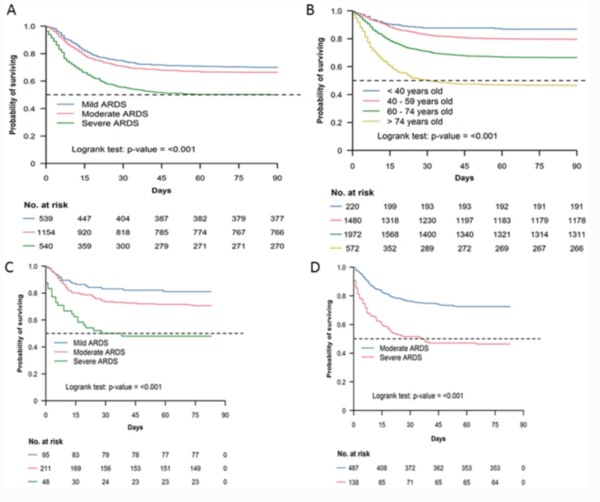To describe acute respiratory distress syndrome (ARDS) severity, ventilation management, and the outcomes of ICU patients with laboratory-confirmed COVID-19 and to determine risk factors of 90-day mortality post-ICU admission.
COVID-ICU is a multi-center, prospective cohort study conducted in 138 hospitals in France, Belgium, and Switzerland. Demographic, clinical, respiratory support, adjunctive interventions, ICU length-of-stay, and survival data were collected.
From February 25 to May 4, 2020, 4643 patients (median [IQR] age 63 [54-71] years and SAPS II 37 [28-50]) were admitted in ICU, with day-90 post-ICU admission status available for 4244. On ICU admission, standard oxygen therapy, high-flow oxygen, and non-invasive ventilation were applied to 29%, 19%, and 6% patients, respectively. 2635 (63%) patients were intubated during the first 24 h whereas overall 3376 (80%) received invasive mechanical ventilation (MV) at one point during their ICU stay. Median (IQR) positive end-expiratory and plateau pressures were 12 (10-14) cmH2O, and 24 (21-27) cmH2O, respectively. The mechanical power transmitted by the MV to the lung was 26.5 (18.6-34.9) J/min. Paralyzing agents and prone position were applied to 88% and 70% of patients intubated at Day-1, respectively. Pulmonary embolism and ventilator-associated pneumonia were diagnosed in 207 (9%) and 1209 (58%) of these patients. On day 90, 1298/4244 (31%) patients had died. Among patients who received invasive or non-invasive ventilation on the day of ICU admission, day-90 mortality increased with the severity of ARDS at ICU admission (30%, 34%, and 50% for mild, moderate, and severe ARDS, respectively) and decreased from 42 to 25% over the study period. Early independent predictors of 90-day mortality were older age, immunosuppression, severe obesity, diabetes, higher renal and cardiovascular SOFA score components, lower PaO2/FiO2 ratio and a shorter time between first symptoms and ICU admission.
Among more than 4000 critically ill patients with COVID-19 admitted to our ICUs, 90-day mortality was 31% and decreased from 42 to 25% over the study period. Mortality was higher in older, diabetic, obese and severe ARDS patients.
検査で診断されたCOVID-19を有するICU患者の急性呼吸窮迫症候群(ARDS)の重症度、換気管理、および転帰を説明し、ICU入室後の90日死亡率のリスク因子を明らかにすること。
COVID-ICUは、フランス、ベルギー、スイスの138の病院で実施された多施設共同の前向きコホート研究である。人口統計学的データ、臨床的データ、呼吸器サポート、補助的介入、ICU滞在期間、および生存率のデータを収集した。
2020年2月25日から5月4日までに、4643人の患者(中央値[IQR]年齢63[54-71]歳、SAPS II 37[28-50])がICUに入院し、4244人についてはICU入院後90日目の状態が確認できた。ICU入室時に、標準的な酸素療法、高流量酸素、非侵襲的人工呼吸がそれぞれ29%、19%、6%の患者に適用された。2635人(63%)の患者で最初の24時間に挿管されたが、全体では3376人(80%)がICU滞在中に一度は侵襲的な機械的換気を受けた。呼気終末圧とプラトー圧の中央値(IQR)は,それぞれ12(10~14)cmH2Oと24(21~27)cmH2Oであった。MVが肺に伝達する機械的パワーは26.5(18.6~34.9)J/minであった。Day-1で挿管された患者の88%と70%に、麻痺剤と腹臥位が適用された。これらの患者のうち207名(9%)と1209名(58%)に肺塞栓症と人工呼吸器関連肺炎が診断された。90日目には、1298/4244例(31%)が死亡した。ICU 入室日に侵襲的または非侵襲的な人工呼吸を受けた患者では、90 日目の死亡率は,ICU 入室時の ARDS の重症度に応じて上昇し(軽度,中等度,重度の ARDS ではそれぞれ 30%,34%,50%)、研究期間中に 42 から 25%に減少した。90日目死亡率の初期の独立した予測因子は、高齢、免疫抑制、重度の肥満、糖尿病、腎臓および心血管のSOFAスコア成分が高いこと、PaO2/FiO2比が低いこと、最初の症状からICU入室までの時間が短いことであった。
当院のICUに入院した4000人以上のCOVID-19の重症患者において、90日死亡率は31%であり、研究期間中に42から25%に減少した。死亡率は、高齢者、糖尿病患者、肥満患者、重症ARDS患者で高かった。
(図)A)Day-1で侵襲的人工呼吸または非侵襲的人工呼吸を行っている患者の急性呼吸困難症候群の重症度、B)年齢区分、C)Day-1で軽症のARDS患者の7日以内のARDS重症度の進行、D)Day-1で中等症のARDS患者の7日以内のARDS重症度の進行に従って、ICU入室後90日間のKaplan-Meier生存率を推定した。*7日目に生存していた患者のみをこの分析に含めた。ICU 集中治療室

https://link.springer.com/article/10.1007/s00134-020-06294-x